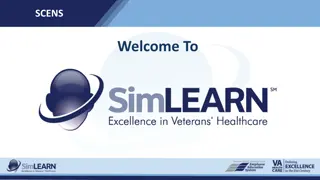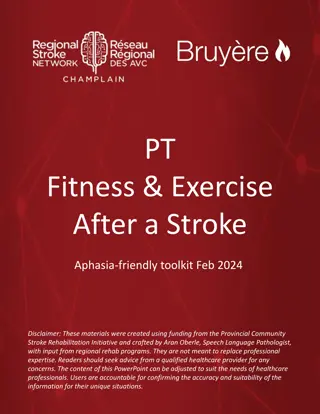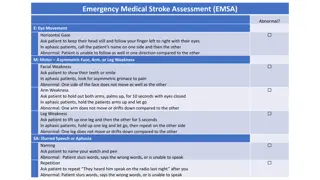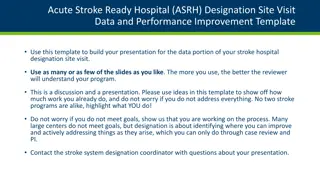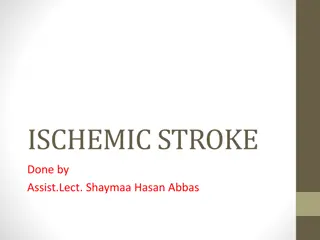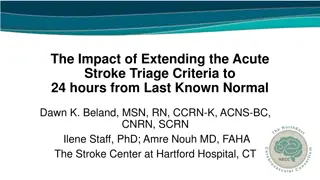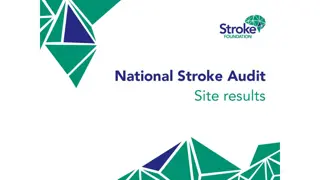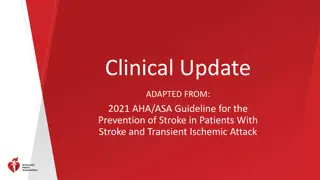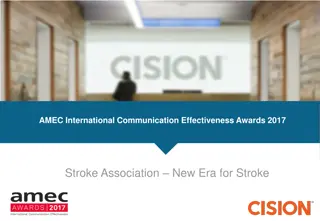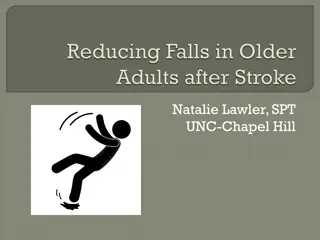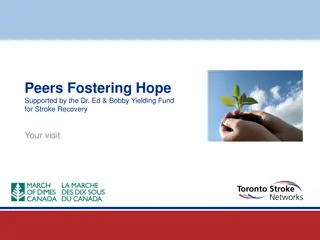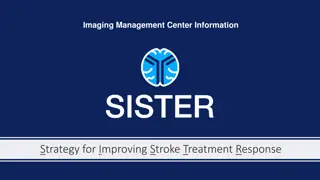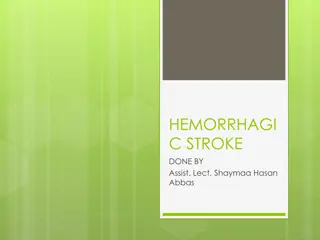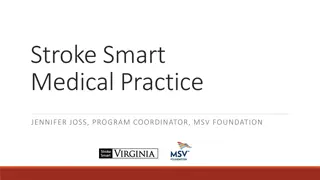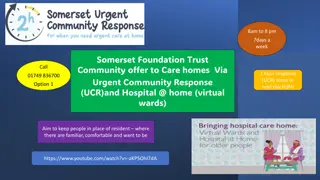Comprehensive Approach to Enhancing Stroke Treatment Response
Enhance stroke treatment response by focusing on strategies, training, contacts, learning goals, and processes. Understand the screening criteria, consent process, inclusion criteria, and steps for site readiness. Key contacts for project management and training are provided for a successful stroke treatment initiative.
Download Presentation

Please find below an Image/Link to download the presentation.
The content on the website is provided AS IS for your information and personal use only. It may not be sold, licensed, or shared on other websites without obtaining consent from the author. Download presentation by click this link. If you encounter any issues during the download, it is possible that the publisher has removed the file from their server.
E N D
Presentation Transcript
Study Coordinator Training
Contacts SISTER Project Managers Pam Plummer plummepa@ucmail.uc.edu (513) 885-2437 NDMC Data Managers Katie Stever Riley Luckmann steverca@musc.edu luckmann@musc.edu (843) 876-1114 NDMC Monitoring Manager Aaron Perlmutter perlmutt@musc.edu (843) 792-2784 Email & Clinical Hotline # Randomization Hotline # sister-trial@ucmail.uc.edu (866) 212-7187( (866) 450-2016
Learning Goals The Coordinator will understand: The process for their site to be released to enroll (site readiness). Screening criteria to identify the appropriate subject. The consenting process using the ICF or eConsent. Study Medication Procedures Study Labs WebDCU Subject Visits Study payments Toolbox Resources Quiz link will be displayed so you can follow along and complete
Process For Release to Enroll cIRB approval must be obtained. CTA is executed. WebDCU DoA is completed and approved. The team must include the PI, PSC & PPh. Other team members may be added as desired. Only 1 role is assigned to each team member. Tasks are assigned as needed. All team member training has been completed and attestation forms or certificates have been uploaded into the WebDCU regulatory database. This includes all required people documents. Study drug and lab supplies have been received and registered in WebDCU . These will be sent following the readiness call. Readiness call has been completed.
Screening & Consent I/E Criteria Screen Failures The Consent Process Subject Consent eConsent Using an LAR
Screening Criteria - Inclusion 1) 2) 3) 4) >18 years of age Suspected anterior circulation acute ischemic stroke NIHSS >6 on presentation Baseline neuroimaging consisting of all of the following: 1) ASPECTS score of >6 on CT or >7 on MRI 2) Favorable perfusion imaging on CTP / MR-perfusion weighted imaging (PWI) consisting of the following 1) Mismatch ration of penumbra : core >1.2 2) Mismatch volume >10 cc 3) Core <70 cc Able to receive assigned study drug within 4.5 to 24 hours of stroke onset or last know well Able to receive assigned study drug within 90 minutes of qualifying perfusion imaging (administration is encouraged within 60 minutes but up to 90 minutes is allowed. After 90 minutes, another perfusion image is needed to ensure that inclusion criteria are met) Informed consent for study participation obtained from participant or their LAR 5) 6) 7)
Screening Criteria - Exclusion 1) 2) 3) 4) Plan to receive endovascular treatment Received or plan to receive IV thrombolysis Pre-stroke mRS >2 Previous treatment with TS23 or known allergy to antibody therapy Known pregnancy, breastfeeding or plan to breastfeed within 3 months or have a positive urine or serum pregnancy test. Known previous stroke in the past 90 days. Known previous ICH, intracranial neoplasm, subarachnoid hemorrhage or AV malformation. Know active diagnosis of intracranial neoplasm Clinical presentation suggestive of a subarachnoid hemorrhage, even if initial CT scan was normal. 10) Surgery or biopsy of parenchymal organ in the past 30 days 11) Known trauma with internal injuries or persistent ulcerative wounds in the past 30 days. 12) Severe head trauma in the past 90 days. 5) 6) 7) 8) 9)
Screening Criteria - Exclusion 13) Persistent SBP >180mmHg or DBP >105mmHg despite best medical management. Serious systemic hemorrhage in the past 30 days. Known hereditary or acquired hemorrhagic diathesis, coagulation factor deficiency, or oral anticoagulant therapy with INR >1.7 Platelets <100,000/mm3 Hematocrit <25% Elevated PTT above laboratory upper limit of normal. Creatinine >4mg/dl or patients receiving renal dialysis, regardless of creatinine Received heparin or low molecular weight heparins in full therapeutic dose within the previous 24 hours. Received Factor Xa inhibitors within the past 48 hours Received direct thrombin inhibitors within 48 hours. Received glycoprotein IIb/IIIa inhibitors within past 14 days. Known pre-existing neurological or psychiatric disease which would confound the neurological/functional evaluations. Current participation in another research drug treatment Concurrent acute MI, PE, DVT, or other thrombotic event that requires anticoagulation or anti-platelet treatment. 14) 15) 16) 17) 18) 19) 20) 21) 22) 23) 24) 25) 26)
Screen Failures The Screen Failure Log in WebDCU will be utilized for the SISTER study. Screen failures are to be entered in real-time, not monthly. Who to enter into the screening log? What information to enter? Acute ischemic stroke patients Presented within 4-23 hours of last known well Not treated with standard of care acute stroke reperfusion therapies, including thrombolysis and thrombectomy. Demographics Screen failure details Eligibility criteria
The Consenting Process Obtaining informed consent is not just having the potential participant sign a document. It is an interactive process of presenting the study to the potential participant and/or family, allowing the patient/family time to review, and answering all questions. After all is understood and the patient wants to participate, the ICF is then signed. The informed consent process should encompass the following: A copy of the ICF for the potential participant &/or family to review. Disclosure to potential participant the information that is needed to make an informed decision. Ensuring the potential participant understands what has been disclosed Promotion of decision to participate is voluntary SISTER will use a standard version of the ICF. The ICF will have HIPAA language included however, if required, the site may have a stand-alone HIPAA document approved. All research activities will take place after the ICF has been signed by the participant or LAR.
The Consenting Process - eConsent The SISTER ICF can also be produced in eConsent form for ease of signing. The eConsent process must be approved by the cIRB. It is highly recommended that you use the eConsent. Having the eConsent available on your site s tablet is a more efficient and error-free process of obtaining the patient or LARs consent. The patient or LAR may sign the eConsent. Before having access to an eConsent, your site must be approved by submitting the Implementation Form to the cIRB that indicates your desire to use the eConsent and/or remote consent. Our eConsent documents will use the REDCap platform. Your eConsent will be produced using your cIRB approved documents. You will be provided a user ID, a user guide and training to use the REDCap platform and your eConsent.
The Consenting Process - LAR An LAR is a Legally Authorized Representative that can act make decisions on behalf of another person. An LAR can be but is not limited to, Spouse Legal Guardian Adult child Parent Does the subject have the cognitive capacity to decide about study participation? This assessment should be made by a study investigator and documented in the subject s records. No, then LAR signs and dates When subject regains capacity, they should sign a new consent themself Yes, the subject signs and dates the ICF If the subject is physically incapable of signature, illiterate, visually impaired, or signing a short form consent, utilize witness of consent process and signature All research activities will take place after the ICF has been signed by the participant or LAR.
Study Medication Procedures Receipt of study drug Randomization Administration Documentation
Receipt of Study Drug Study drug can be shipped to your site when, 1) CTA has been executed 2) DoA has been added and approved, 3) Site addresses have been entered into WebDCU , 4) Pharmacy license has been uploaded and approved by the Central Pharmacy with shipping address verified, 5) All site and people regulatory documents have been uploaded into WebDCU and approved by the PM, 6) Readiness call has been completed. An initial inventory of 1 box, which contains 6 vials, has been set by the central pharmacy. The box will be shipped when requested by the PM. An automatic email will be sent to the site when the study drug has been shipped. When the study drug is received at the site, it must be logged into WebDCU within 2 days of receipt. This is done by the pharmacist or designee. Instructions on how to mark study drug received is in the WebDCU user guide. Inspect study drug. If any boxes appear damaged, notate this in the WebDCU by removing from inventory (see user guide). Maintain study drug shipping receipts in your site regulatory binder. Document study drug on site inventory log filed in site regulatory binder. The Central Pharmacy will be alerted when refills are needed and automatically ship the study drug to maintain your site s inventory. Study drug replacement shipment may vary from 1-6 vials based on site s enrollment and current inventory. Information on drug labeling is in the Pharmacy MOP.
Randomization When criteria has been met for inclusion into the study and the patient or LAR has signed the ICF, randomization can occur. Before Randomization Subject Enrollment must be completed in WebDCU for randomization. All other forms can be data entered later to avoid delaying study drug administration. Baseline imaging will need to be uploaded as soon as possible Delegated team member can randomize the subject in WebDCU . Form 102 is completed, and the subject is randomized to a treatment assignment Study drug mixing Print Randomization Verification Form and take to the pharmacist for the study drug to be prepared. This form will contain a 4-letter randomization code that the pharmacist will use to determine treatment arm and dosing. After study drug is prepared, it is delivered to the ED for study drug administration.
Study Drug Administration The research team will educate the clinical staff regarding the study drug administration. Pre-administration labs have been drawn SOC labs upon hospital presentation: Glucose, creatinine, PTT, PT w/INR, CBC, platelet count HgbA1C & Lipid Panel document first lab results obtained during hospitalization Pre-administration labs: Fibrinogen, 2AP, MMP-9 levels & PK studies. TS23 will be administered as an IV infusion over approximately 15 minutes. The subject will be monitored closely during the administration for any adverse events
Post-Administration & Documentation The subject will be closely monitored after study drug administration for any adverse events. Document subject s reaction to the study drug administration. Post-administration labs 3 hours (+/- 1 hr.): Fibrinogen, 2AP, MMP-9 levels & PK studies. Documentation on WebDCU F206 & on source document Study drug administration start & stop time Flush times Subject s status after receiving study drug Documentation of any events that occur during or after the study drug administration Lab times
Study Labs Collection & Shipping Kits Processing Freezing Shipping
Lab Collection & Shipping Kits You will be provided sample collection kits at the start of the study and throughout as needed. The initial shipment will contain 10 kits and will be resupplied when the inventory drops to 3 kits. Upon receipt of the collection & shipping items, the site will confirm the kits received in WebDCU . If a kit is lost or misused, you will need to document that in the inventory in WebDCU so it can be replaced. The items needed to obtain the labs will be the site s responsibility. Funds have been included in the in-hospital visit payment to cover the cost of the lab supplies.
Sample Processing Obtain a collection kit Obtain the blood samples following local institutional policies and procedures. Process the sample according to the instructions in the Lab MOP. If processing needs to be delayed, tubes can be held at 4oC for up to 4 hours prior to centrifugation Transfer the plasma into the provided cryovials. Apply the cryo-labels to the cryovials and record on form for input into WebDCU
Freezing The samples will be stored in a -80oF freezer until shipment to the core lab. Complete the sample box grid form and retain until shipment.
Shipping The frozen samples will be shipped to the University of Arizona lab, every 6 months, using FedEx Priority Overnight courier service. A copy of F181 Biospecimen Collection Processing will be included within the box along with the corresponding eCRF Cryobox Storage Matrix Form Pack specimen and ship specimens as indicated in the core lab MOP See core lab MOP for lab closures for holidays Documentation of sample shipping will be made in WebDCU . Receipt of labs will also be verified. Once samples for each subject have been verified as received, this includes all required samples, the payment for those labs will be processed. See the lab MOP for all instructions on obtaining, processing, and shipping the specimens.
WebDCU Data Collection Guidelines Document Parameter Guidelines User Manual Training
Data Collection Guidelines The Data Collection Guidelines, published by NDMC, is a booklet to guide you through entering data into WebDCU . The booklet will be added to the WebDCU toolbox for the SISTER study. All data is to be entered into the subject s binder in WebDCU within 5 days of collection. For randomization to occur, the subject enrollment form must be completed. Once randomization has occurred, you can then go back and complete the eligibility form (F101) and all other CRFs needed. Screen Failures are entered into WebDCU as they occur, not monthly. Site payments are contingent upon complete subject data being entered into WebDCU , query free.
Document Parameter Guidelines The Document Parameter Guidelines is a document that guides you in the requirements of your regulatory documents that are uploaded to WebDCU and also contained in your site regulatory files. These include but are not limited to: Site Documents People Documents cIRB Approval cIRB Approved ICF CV Medical/Professional License Site Documents cIRB Approved Translated ICF Protocol Signature Page HSP Training Certificate GCP Training Certificate Local IRB Acknowledgement Site-specific BOR, if applicable NIHSS Training Certificate mRS Training Certificate Site-specific HIPAA, if applicable Site Pharmacy License Protocol Training Certificate SC Training Certificate cIRB Approved Translated Short Translated copy of BOR &/or HIPAA, if applicable Pharmacy Training Lab Shipment Training Site Documents Form ICFs Institutional Drug Destruction Policy or SOP Imaging Upload Training ASPECTS Training cIRB Approved Administrative Amendments, when applicable Financial Disclosure Form Specimens Collection Training cIRB Approved Translated ICF Protocol Signature Page cIRB Approval Approved ICF This document is stored in the WebDCU toolbox under your StrokeNet studies. FDA Form 1572 CAP/CLIA Certification HIPAA Authorization for Screening Lab Reference Ranges
WebDCU User Manual The WebDCU User Manual is your go-to guide for working with our data collection management center. The manual will cover the following and more: Logging in & out NDMC Study contact list Uploading Regulatory Documents Project Documents, i.e. worksheets Data Entry how to The WebDCU User Manual is available in the WebDCU toolbox.
Training Training for WebDCU is in the WebDCU training center located on the login page. No WebDCU login is needed to access the training center. https://webdcu.musc.edu/login.asp
Training continued Multiple trainings are available in the training center, including: mRS NIHSS WebDCU CTMS Training Preparing for a Monitoring Visit SISTER specific training as well as attestation forms for the training will be added Protocol Pharmacy SC Imaging
Subject Visits In-Hospital Day 30 Visit Day 90 Visit
In-Hospital Visit Subject identified Consent executed Demographics Medical History Vital Signs Con Meds at time of stroke Pre-stroke functional state Labs upon hospital presentation Baseline NIHSS upon arrival Brain & Vascular imagining at presentation Stroke Time Metrics: LKW, symptoms 1st observed Outside Hospital Date/Times, if applicable Hospital arrival data Pre-study drug administration labs: fibrinogen, 2AP, MMP-9, PK studies; CBC if not done within 24 hrs. of randomization Randomization time Study drug start & stop times Flush start & stop times Randomization
In-Hospital Visit 3 hours (+/- 1 hr.) Labs: fibrinogen, 2AP, MMP-9, PK studies Post Study Drug Administration Labs 30 hrs. (+/- 4 hrs.): fibrinogen, 2AP, MMP-9, PK studies, CBC, PT/INR, aPTT 30 Hours Assessments 30 hrs. (+/- 4 hrs.): VS, CT/MRI, CTA or MRA, if applicable, CT/MR perfusion, AEs, SAEs 72 Hours NIHSS assessment Antithrombotic meds during hospitalization DVT prevention during hospitalization Hospital D/C (whichever is 1st) Medications at discharge Stroke Mechanism TOAST criteria NIHSS (if D/C prior to 72 hrs.) Discharge destination Ambulatory status & mRS at D/C AEs. SAEs. Or Unanticipated Problems
Day 30 Visit (+/- 5 days) The 30-day post study drug administration visit should be conducted in person. If conducted in-person, the visit payment includes a $75 subject payment for time & travel. If the SC completed an in-person visit at the subject s home, then the $75 payment can be used for the SC travel and no subject payment is made. Study Assessments to be completed: mRS NIHSS Collect con med information Collect discharge summary Report any AEs, SAEs, or Unanticipated problems
Day 90 Visit (+/- 7 days) The 90-day post study drug administration visit must be conducted in-person as a lab draw is needed. If the subject attends the visit on the site s office/clinic, then they will receive a $75 payment for their time & travel. These funds are incorporated into the 90-day visit. If the SC conducts the 90-day visit at the subject s home, then the $75 may be applied to the SC s travel and the subject will not receive the payment. Study assessments to be completed: mRS NIHSS Con meds Labs: PK studies SOC labs if collected: CBC, CMP, Lipid profile
Adverse Events Serious Adverse Events Unanticipated Events Assessing Reporting
Assessing for Adverse & Serious Adverse Events The SC plays a key role in the discovery of any Adverse Event (AE) or Serious Adverse Event (SAE). If an AE/SAE is discovered during time spent with the subject or medical record review, the SC should obtain all data and present to the PI/SubI for assessment of the AE/SAE. The PI is responsible for assessing any AE or SAE that occur with their subjects. This task can also be delegated to the site SubI(s). The PI should assess for the following: Severity Relationship to Study Intervention Expectedness Action taken regarding study drug Other actions taken Outcome Documentation of any AEs should be maintained at the site in the subject s research binder, with PI acknowledgement, and reported in WebDCU .
Reporting AEs/SAEs Reporting of an AE occurs via WebDCU 1) Enter the subjects CRF Binder 2) Click on your subject number 3) Click on F104 Adverse Event CRF 4) Enter the data following the questions in the form 1) Please make sure to answer Q3, Serious , yes or no Reporting requirements AEs within 5 days of discovery SAEs - within 24 hours from discovery. The SAE report does not have to be complete but at least started and submitted.
Unanticipated Events/Protocol Deviations Unanticipated events (UEs) are those that are unexpected and may involve an increased risk of harm to the research subject. These may also include protocol deviations. Examples of UEs: Consent form errors, i.e., not using a witness when applicable, using incorrect version, etc. Subject not meeting inclusion criteria for study Out of window visit, i.e., incorrect specimen draw time Non-compliance by site or subject Researcher error Breach of confidentiality, i.e., sending unsecured email with PHI UEs are reportable using the StrokeNet Unanticipated Event/PD Report in WebDCU . UEs that meet certain criteria will also be reported to the cIRB per the NCC PM.
Toolbox Resources SISTER Documents will be stored in the Toolbox in WebDCU . Manuals & Protocol Instruction Documents Regulatory Documents Pharmacy Documents Tools for Site & Subjects
Toolbox Resources Manuals & Protocols Protocol The most current version of the protocol will be maintained in the toolbox. Investigator Brochure The IB is available in the toolbox. Manuals All current MOPs are available in the toolbox; these include: Protocol MOP Pharmacy Lab Imaging
Toolbox Resources Instruction Documents All instructional documents will be made available in the toolbox, these include but are not limited to, Frequently Asked Questions (FAQ List) How to create a digital signature Readiness Checklist Preparing PDFs for Upload into WebDCU Enrollment, Randomization & Visit Checklists
Toolbox Resources Regulatory & Pharmacy Documents All PRIME approval letters and Pharmacy documents will be added to the WebDCU toolbox which include, Initial approval letter for the study All modification letters Temperature Excursion Report Form PRIME approval letters will also be emailed to the site.
Toolbox Resources Tools for Sites & Subjects The WebDCU Toolbox will also contain many tools for the sites and subjects. All subject tools will be cIRB approved prior to uploading into the toolbox. These tools may include, but are not limited to: Visit scheduler Letter to subject s PCP Visit Checklists Accountability logs for lab storage kits, study drug Wallet card UAE/PD Checklist Lost-to-follow letter to subject I/E card for team members
Payment Schedule Start-Up Screen Failure In-Hospital Visit 30-Day Visit 90-Day Visit Other Payments
Start-Up Payment - $3750 A non-refundable start-up payment totaling $3,750.00 will be made in one payment (inclusive of F&A, pharmacy and IRB fees, as applicable) when the site has been released to enroll in the WebDCU . This payment includes receipt of cIRB approval, execution of the CTA and completion of required study training and acknowledgement of study drug and lab supply shipments.
Per Subject Payment Schedule Payments are contingent upon all of the following: Subject completing the study visits All visit data has been saved and submitted in WebDCU All queries resolved WebDCU has a date first ready Payments are inclusive of: StrokeNet F&A costs Research related CTP imaging, completed and uploaded, if applicable $75 travel subject payment If travel is completed by the site coordinator, the funds can be used to reimburse the study personnel
Screen Failure Payment Perfusion Imaging - $850.00 This payment covers the cost of a research related CTP & consent if the subject does not progress to study drug administration. If there are more than 3 screen failure imaging fees paid out to the site without any subject enrollment (defined as study drug initiated) then the National PIs will decide on further screen failure imaging Payouts on a case-by-case basis.
In-Hospital Visit - $7299.60 Visit Payment includes the following Screening & Screen Failures Imaging costs for screen failure patient is included 30-hour labs and imaging Research related imaging 72-hour NIHSS Consent Discharge Visit Randomization Obtaining & uploading protocol required images into central repository Study Drug administration Collection, processing and results for the Fibrinogen 3-hour visit Payment of specimens will be completed when all study required specimens are received at the core lab
30-Day Visit - $437.50 Payment includes: NIHSS assessment Con-med collection AE/SAE Assessment & collection Subject or site payment for travel travel subject payment of $75.00 for each of the post hospital visits if the SC travels to the subject s home to complete the 30-day visit, the $75.00 for the visit can be used for site travel reimbursement instead of subject payment.
90-Day Visit - $1188.05 Payment includes: NIHSS assessment Specimen collection payment for specimens will be applied when specimens are received at the central lab. Con-med collection AE/SAE Assessment & collection Subject or site payment for travel time & travel subject payment of $75.00 if the SC travels to the subject s home to complete the 90-day visit, the $75.00 for the visit can be used for site travel reimbursement instead of subject payment. Please note: if this visit is completed remotely, the payment will be reduced to $75 and lab specimen collection will not be complete, voiding the specimen collection payment of $800





